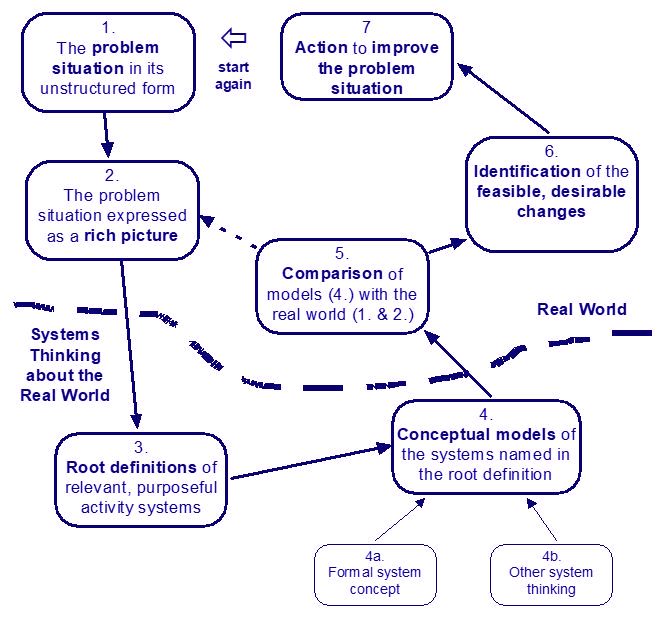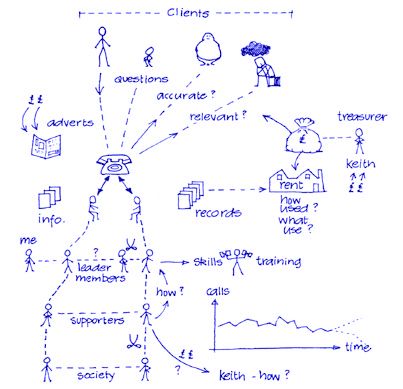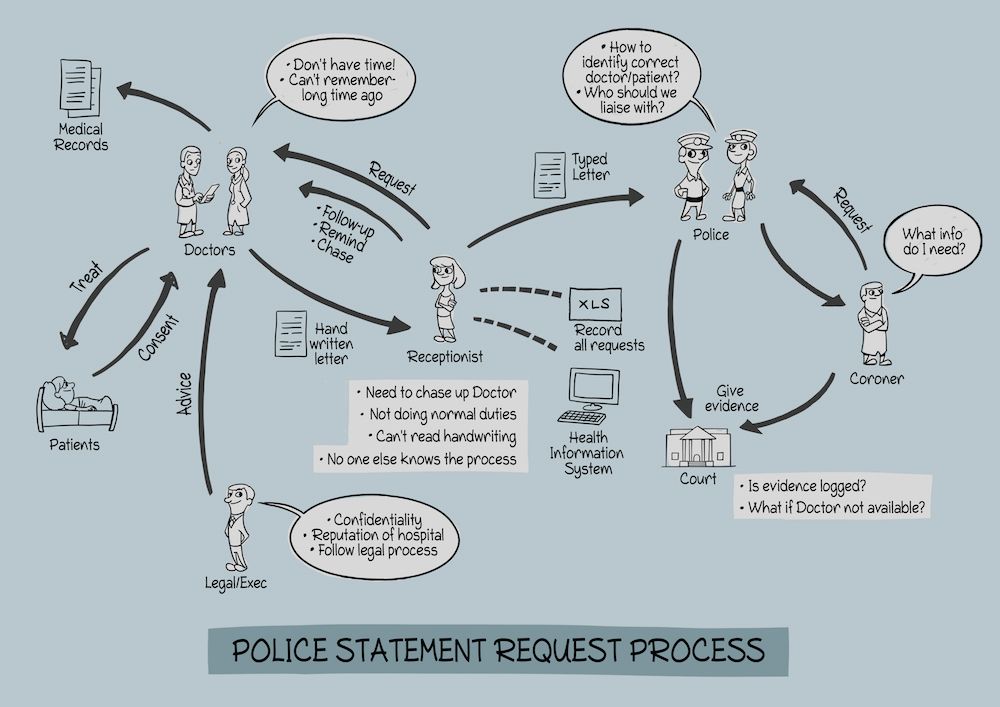Section 0: Module Objectives or Competencies
| Course Objective or Competency | Module Objectives or Competency |
|---|---|
| The student will develop an awareness of and be able to discuss the complexities of requirements determination. | Students will be able to explain the difference between hard and soft problems. |
| The student will be able to list and explain what human activity systems involve. | |
| The student will be able to list and explain the concepts behind the soft systems methodology. | |
| The student will be able to use Rich Pictures and CATWOE to determine the features of an unstructured problem. |
Section 1: Overview
Hard (structured) Problems
A structured or "hard" problem can be defined as
- a person or organization that has a problem
- one (or more) desired ends that haven't been attained
- at least two alternative courses of action that could be used to attain the end
- A statement of doubt about which alternative is preferable
- An environment of uncontrollable variables that can affect the ends sought
These can be considered structured problems and can be analyzed using structured approaches.
Hard problems have a clear problem statement and analysis can determine a set of recommended steps to follow.
Soft (unstructured) Problems
In many cases, the exact problem and way forward is not always straightforward.
- A clear example occurs when different people have differing opinions on the cause of a problem.
- In situations where stakeholders have multiple and diverging interests, the analyst faces the challenge of proposing a plan of action that all parties can live with.
An unstructured or "soft" problem typically involves a "messy", poorly defined, unstructured situation.
They generally cannot be explicitly stated without appearing to simplify them.
- (Possibly) requires a "holistic" or "soft" systems approach.
- Combination of technical, organizational and human complexity.
Example: Should we put in self serve terminals? (unions, customer reaction, competitive edge, best use of capital). Many of these are intangibles.
Example: Midas Solutions experienced decreasing revenue during the past year. Fred, a business analyst, was called in to identify what the problem was and proffer recommendations. As a first step, he set up interviews with all the stakeholders concerned. Each stakeholder, in turn, provided different reasons for the loss in revenue. The blame flew from one interest group to another. With everyone passing the buck and none willing to accept responsibility, Fred was bombarded with different definitions and probable causes of the problem. He found himself right in the middle of a political firestorm, one in which there was no easy answer or clear solution.
Section 2: Human Activity Systems
Soft Systems Methodology and some of the tools seen later in these notes were specifically developed for soft problems, which tend to involve system elements, most commonly people, whose behavior is unpredictable.
Human activity systems (HAS) are systems that achieve their purpose through human activity as opposed to software intensive systems or hardware (product) intensive systems.
A human activity system can be defined as a "notional system (i.e., not existing in any tangible form) where human beings are undertaking some activities that achieve some purpose" (Patching, 1990).
Hence, human activity systems are soft systems. They are collections of people undertaking activities to achieve some purpose, and are soft because:
- The boundaries or scope of the human activity system may be fluid.
- The purpose of the system may be problematic and certainly open to interpretation.
- It may be difficult to precisely define exact measures of performance for the human activity system.
Characteristics of a Human Activity System
- Is an assembly of people and other resources organized into a whole in order to accomplish a purpose. The people in the system are affected by being in the system, and by their participation in the system they affect the system. People in the system select and carry out activities – individually and collectively – that will enable them to attain a collectively identified purpose.
- Maintains sets of relations – sustained through time – among those who are in the system. The maintenance of these relations is of primary importance. The process by which these relationships are maintained is the system's regulation – the rules of the game – and the limits within which these rules can be sustained are the conditions of the systems stability through time,. It is here where commitment (to shared purpose) and motivation (to carry out activities) play such an important role,
- Is open to and interacts with the environment; depends on it and contributes to it. The nature of its relationship with the environment is mutual interdependence. This interdependence imposes constraints and expectations on both the system and its environment responsively. The environment is expected to provide the resources and support that are required by the system.
- Acts as a whole toward itself and by itself – by its internal relations and internal integration -- by which it can also sustain itself. Thus, while we view the system as a whole, at the same time we consider it as part of – and embedded in – its environment.
- Systemic insight emerges from "application" of the dynamics of purpose seeking and purpose-fulfilling relational interaction and integration of the people as a system and its environment.

Section 3: Soft Systems Methodology
Soft Systems Methodology (SSM) is concerned with problematic situations where a problem is known to exist but is difficult to define.
SSM began as a modelling tool but is now widely regarded as a learning tool.
- SSM is not a technique but a "set of principles" that structures the analyst's thinking of the problem situation.
- SSM is a way of thinking about the real world (systems thinking), and its principles are centered on comparing the world as it is with what it might be.
Soft systems thinking is concerned with defining the options for improvement, generally with relation to addressing the what to do question.
- It is essentially committed to the examination of human activity.
- The Soft Systems Methodology (SSM) is not a system design tool, but a tool for system requirements investigation.
- SSM was one of the outcomes of a study by Peter Checkland attempting (unsuccessfully) to apply systems analysis and software engineering approaches (i.e., hard systems) to "messy" management problems (human activity systems).
- Human Activity Systems are systems that achieve their purpose through human activity as opposed to software intensive systems or hardware (product) intensive systems.
- To better understand SSM, please download and read The Use of SSM.
SSM applies to situations in which
- The problem is poorly defined and the cause is unclear. The analyst digs in with the objective of: a) Identifying the problem and b) Proposing a course of action that is both desirable and feasible.
- The problem is unstructured, with different parties having different opinions on what is wrong and what can be done to solve the problem.
The seven stages of SSM are shown in the figure below:

Stages Explained
The following is from Soft Systems Methodology
The stages in SSM are not meant to be followed in a linear fashion.
- Stages may be skipped, refined, iterated or followed depending on the peculiarities of the situation.
- The analyst moves from the real world of gathering information about the situation (elicitation), to the model world of systems thinking (analysis) and back to the real world to verify the requirements (verification).
Stages 1 and 2
Problem Situation Unstructured – This is where the analyst is faced with the messy situation and he decides what exactly is to be explored.
- He tries to make sense of it by arranging interviews with stakeholders, conducting observation sessions, document analysis and generally gathering all the data that is needed to understand the situation.
Problem Situation Expressed – At this point, the analyst has gathered enough information to express the situation in the form of pictures.
- A rich picture is a graphical representation of the situation that attempts to capture both the subtle and the overt.
- Power structures, communication lines, processes, interest groups and differing world views (Weltanschuung) are captured.
- Checkland provides a guideline of what can be included in a rich picture: structure, processes, people, concerns, conflict and climate.
Here is an example of a rich picture from the Open University:

It is a snapshot of the problematic situation that reveals differing perspectives, and captures the formal and informal aspects of the problem situation. More on rich pictures in the next section.
Stage 3: Root Definition
Through stages 1 and 2, the analyst proposes a root definition of a system that is relevant to solving the problem. Here, the analyst enters the world of systems. A root definition is usually framed as:
A system to do X by means of Y to achieve Z.
Many root definitions of the relevant system can be developed based on as many world views (Weltanschuung) as there are.
- The analyst should however, identify the “primary task” root definition which represents the official task of the system.
- A popular mnemonic called CATWOE, framed by Checkland, is used for constructing the root definition, and will be discussed in an upcoming section.
Stage 4: The analyst forms a model of activity for each root definition
Here, the analyst proposes a list of verbs comprising activities necessary for the transformation.
- The model is only a tool for facilitating discussions with stakeholders and is not an end in itself; it should be used as a tool for raising questions and interacting with stakeholders until understanding is achieved.
- The iterative nature of SSM allows the analyst to draw a model, discuss its implications with stakeholders and then redraw as needed.
Running through as many models as possible, allows the analyst to compare differing world views and identify contradictions/recurring themes between models.
- Basically, the more models analysts build, the more they’re able to understand other perspectives and defend their positions in front of stakeholders.
Stage 5: Comparison of model with real life
In this stage, the analyst compares the model with what happens in real life
- The objective is to highlight any differences, complexities, contradictions and inadequacies of reality.
Stage 6: Feasible, desirable change
The objective at this point is to determine which changes can be implemented.
- Any recommended change must be compatible with the organizational culture and acceptable to all participants.
- While a peaceful negotiation will not result in a 100% satisfaction of all stakeholders, it will ensure that a solution that all parties can live with is identified.
Stage 7: Action is taken to improve the problem situation
One of the advantages of SSM is that it allows the analyst address key perspectives of how a system should work by understanding their implications and reintegrating these perspectives to provide a practical solution to business problems.
Section 4: Rich Pictures
A Rich Picture is a way to explore and define a situation and express it through diagrams to create a preliminary mental model.
-
Developing a rich picture covers steps 1 & 2 of the SSM which describe
the real world:
- Identify the issue you wish to address
- Develop an unstructured description of the situation where the issues lies – how it is
Overview (swf)
Example (swf)
Guidelines
Here are some guidelines as to what should be included in the description so that a rich understanding of the situation is developed:
- Structures
- Processes
- Climate
- People
- Issues expressed by people
- Conflict
The description of the situation is depicted as a picture using diagrams, symbols, cartoons and words.
- the picture should not structure the situation
- a rich picture is to reflect as much going on as possible without privileging, predetermining, or presuming a particular point of view.

Suggested process:
- Start by asking people to note all the physical entities involved, for example, the critical people, organisations or aspects of the landscape.
- Ask people to present their rich picture by describing the key elements and key linkages between them.
- If there is more than one group, compare their pictures and cluster the ideas that are similar and those that diverge. In this way you can identify the most important issues to discuss, such as critical topics to focus on in an evaluation, possible indicators or key stakeholders to include.
See Rich Pictures for more details.
Section 5: CATWOE
Stage 3 in SSM is Root Definition of relevant, purposeful activity systems.
- Before creating a model, it is necessary to select a viewpoint, and then define appropriate systems from that perspective. This is achieved by constructing a root definition.
-
The mnemonic CATWOE is used to check that all the necessary components are in the root definition.
-
C – Clients or customers: beneficiaries or victims of the proposedsystem
- Who is on the receiving end?
- What problem do they have now?
- How will they react to what you are proposing?
- Who are the winners and losers?
-
A – Actors who carry out activity in the system
- Who are the actors who will ‘do the doing’, carrying out your solution?
- What is the impact on them?
- How might they react?
-
T – Transformation: means through which inputs become outputs
- What is the process for transforming inputs into outputs?
- What are the inputs? Where do they come from?
- What are the outputs? Where do they go to?
- What are all the steps in between?
-
W – Weltanshaung: Particular way of viewing the situation that makes the root definition meaningful
- What is the bigger picture into which the situation fits?
- What is the real problem you are working on?
- What is the wider impact of any solution?
-
O – Owner: stakeholder with prime concern for the system. He has the power to make the system cease to exist.
- Who is the real owner(s) of the process or situation you are changing?
- Can they help you or block you?
- What would cause them to get in your way?
- What would lead them to help you?
-
E – Environment Environmental Constraints: Features of the environment that affect the operation of the system.
- What are the broader constraints that act on the situation and your ideas?
- What are the ethical limits, laws, financial constraints, limited resources, regulations, and so on?
- How might these constrain your solution? How can you get around them?
-
C – Clients or customers: beneficiaries or victims of the proposedsystem
Example
A practical example of a root definition, starting with the CATWOE is as follows:
- C – Customers
- A – Planning Specialists
- T – Forecasts from salesmen are transformed into a material requirements plan
- W – Aggregation of forecasts from salesmen is a means of achieving an accurate materials requirements plan
- O – Top Management
- E – Specified Data format, Available technology
Now, this CATWOE Analysis may yield a Root Definition such as: a company owned system to generate a material requirements plan (X) by collecting sales forecast from field agents (Y) in accordance with prescribed data standards in order to meet customer demand, increase company revenue and promote company-wide collaboration.
Section 6: Resources
Overview (pdf)
Overview with ExampleExamples (pdf)
Example 1Example 2
Example 3
Example 4
Videos
Soft Systems Methodology
Another on Soft Systems Methodology
One last one on Soft Systems Methodology
Rich Pictures
Rich Pictures 2





